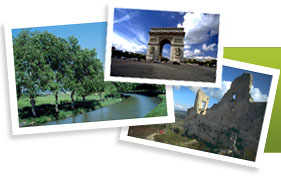Longues-Sur-Mer
La Batterie de Longue-sur-mer
This is the best-preserved German defence post from the Second World War and the Nazi pillboxes still overlook the coast.
Passing through the fishing village of Port-en-Bessin, you will continue west to the hillier coastline of Colleville-Sur-Mer and Omaha Beach. The long stretch of road that lays between the cliff top village of Colleville-Sur-Mer and Omaha beach, houses the two American War cemeteries. The larger of the two, the American Military Cemetery, contains the graves of 9386 American soldiers. Row upon row of crosses covers the expanse of cliff top grass. Set in a peaceful and serene setting overlooking the coast, this is a place for reflection. A further 25km west, lies the site where 21,000 German troops are buried, following fighting at Omaha.
Omaha Beach Museum
Used by the American troops during the D-Day landings of 1944, Omaha beach is located 6km west of the town of Arromanches. The beach museum is situated about 100 metres from the shore in the small village of St-Laurant and has a great collection of photographs taken from the D-Day landings themselves.
Viervilles
Viervilles lies just beyond St-Laurant and was the location for the artificial harbour named Goosebury. In the western area of the town you will finds a memorial to the US National Guard.
Point-du-Hoc
A rocky outcrop that was a strategic lookout and defence position for the German troops during the D-Day landings. As the day wore on it became a site of intense fighting. Today the cliff tops remain scarred with craters and barbed wire but it is still possible to see the bunkers and glance down to the shoreline where all those years go the troops began their struggle to make it to the top.
Further Afield
Arromanches
Once a peaceful fishing village, Arromanches became one of the main areas of Normandy beach used for the Allied landings. Famous for it artificial harbour, Mulberry harbour, Arromanches is an ideal another place to visit for those exploring the battlefields, beaches and cemeteries Normandy.
Musée de Débarquement
The D-day Landing Museum stands opposite the remains of the extraordinary artificial port. " The permanent Landing exhibition " displayed here was created in 1953. Its exhibits include personal belongings, relief maps and working models. Designed by the architect Mr François Carpentier, the museum was actually built on the site of the artificial harbour and its remains can still be seen, a few hundred yards away from the shoreline.
Arromanches 360
Situated on Chemin du Calvaire. The cinema was created upon the initiative of the Lower Normandy Regional Council for the Fiftieth Anniversary of the Landings. The film, Le prix de la liberté (the price of freedom) is an outstanding film and is shown on 9 screens in a circular viewing room, an impressive 360-degree Circorama, this is an experience not to be missed. The cinema itself is one of only three in France and the film is a great and dramatic tribute to the men who fought and lost their lives.
Bayeux
Situated 10km from Bayeux, we suggest a journey to the town to take in its medieval architecture and culinary delights.
Bayeux Tapestry
The Centre Guillaume le Conquérant is located on the rue de Nesmond. The famous Bayeux tapestry recounts, simply but with a wealth of detail, how and why William the Conqueror achieved the conquest of England in 1066. The tapestry is a magnificent 70 metres long and its colour and vibrant scenes of medieval life are quite something. Thought to have been embroidered by Nuns in England and commissioned by William’s half brother, the tapestry is truly one of its kind.
Cathedral of Notre Dame
Cathédral Notre Dame, a short distance away from the Bayeux Tapestry following the rue de Nesmond, this cathedral is one of the oldest buildings in Bayeux. The Notre Dame Cathedral was once the original home to the Bayeux tapestry. The 11th century cathedral boasts some beautiful original architecture alongside the later more gothic additions. The crypt is one of the few remaining Romanesque structures with beautiful frescoes lining the walls. A 12th century nave holds some stunningly carved choir stalls and an 18th century dome, that tops the crossing tower, is a fine example of the combination of architecture and styles used from across the centuries. This cathedral is a particularly beautiful building that has been amazingly preserved throughout Frances turbulent history.
Memorial Museum of the 1944 Bataille de Normandie
Just a few minutes from the D-Day landing beaches, this museum retraces the 77 days of fighting which opposed Allied forces and the Germany army on the soil of Normandy in the aftermath of 6th June 1944. The museum exhibits documents and film of the Normandy landings and there are life-sized models and military props to give people a better understanding of the events that surrounded those troubled days.
British War cemetery
The cemetery lies opposite the Memorial Museum of the 1944 Bataille de Normandie where there are 6000 British soldiers buried.
Clecy
If you visit this beautiful region of France primarily to tour the Battlefields of Normandy then you will probably venture out to Clecy. Situated a bit further out, 10km south of Thury-Harcout, a village approximately 25-30km south of Caen, Clecy sits on a hill overlooking the River Orne.
With a model railway and a great village charm, Clecy is a great stop over point when traveling through the region.


